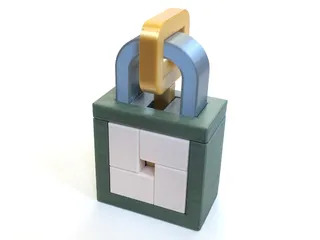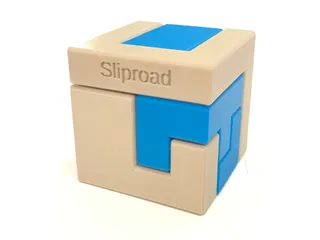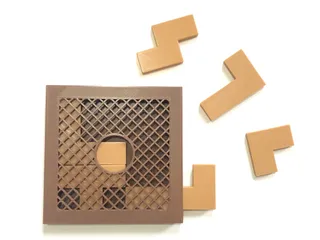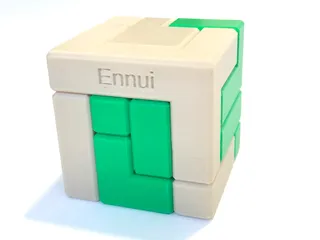Starter Burr Set
Description
PDFStarter Burr Set
The Starter Burr Set is a puzzle set that enables you to make dozens of six-piece burr puzzles. Six-piece burrs are one of the oldest mechanical puzzle forms, dating to at least the 18th century, and it's easy to see why their appeal has endured. The goal looks simple, and it's always the same: assemble six puzzle pieces into the interlocking configuration shown in the second photo... But the challenges vary widely in difficulty, from fairly easy to quite hard, depending on which set of six pieces is selected. Burr sets provide a lot of entertainment in a compact package!
The basic set has 15 pieces, which are intentionally selected so that several puzzles of theoretical or historical interest may be constructed. An optional expansion brings the total number of pieces to 24, greatly increasing the variety of challenges. A pdf booklet contains the list of challenges for both the basic and expanded set, as well as some additional background material on six-piece burrs.
The Starter Burr Set is fully compatible with the much larger Extensible Burr Set, so you can expand the challenge still further once you've exhausted the possibilities of the starter set.
Printing Instructions
For the basic 15-piece set, print one copy each of starter-burr-set.part-1-inset-75.stl and starter-burr-set.part-2-inset-75.stl. For the larger 24-piece set, also print one copy of starter-burr-set.expansion-inset-75.stl.
The suffix inset-75 refers to the tightness of the pieces. Not all printers are alike, so I've generated three versions of the set with different tolerances. inset-75 means that 75 microns of tolerance have been added to each piece; inset-60 will fit tighter, and inset-90 looser. Personally, I prefer the tightest (60 micron) version (I use a Prusa MK3). If you're not sure, 75 microns is a good default.
The expansion uses "snap joints" so that it can be printed without supports. After you print it, first connect all the joints before attempting to solve the puzzle. Snap each male connector into a corresponding female connector (for example, the male connector labeled "A" should connect to the female connector with a matching "A" label on the interior).
The joints are designed to be tight, and depending on the printer and filament used, you may need to hammer them into place. If they come out too loose, a drop of superglue will make them more solid (in most cases this shouldn't be necessary, but unfortunately tolerances vary across printers and filaments). The snap joint concept is discussed further in this tutorial: Getting Started with Puzzle Printing.
Finally, there is an optional tray that holds the printed pieces while not in use. If you want to print a tray (recommended), print starter-burr-set.tray-5x3.stl for the 15-piece version or starter-burr-set.tray-6x4.stl for the 24-piece version.
pdf Booklet
Two versions of the pdf booklet are provided. starter-burr-set.pdf is best for reading on a computer or device. If you want to print a copy (on a 2D printer!), you can print starter-burr-set-booklet.pdf double-sided and fold the pages in half to form an actual booklet; they're laid out so as to appear in the proper order. One of the photos contains a picture of the booklet alongside the burr set.
The Printable Puzzle Project
The Printable Puzzle Project aims to make available high-quality open-source models of many puzzle designs. All of our models are posted with the generous permission of their designers and are licensed for non-commercial use only. Anyone may print copies for their own personal use, but selling or otherwise monetizing them is not permitted, and puzzle designers retain all rights as copyright holders of their work.
Our puzzles are modeled using the open-source puzzlecad library. The .scad file is included with this model in case you want to modify any of its design parameters; more information on how to do this can be found in the PPP Puzzle Modeling tutorial.
Happy puzzling!
Tags
Model origin
The author marked this model as their own original creation. Imported from Thingiverse.




